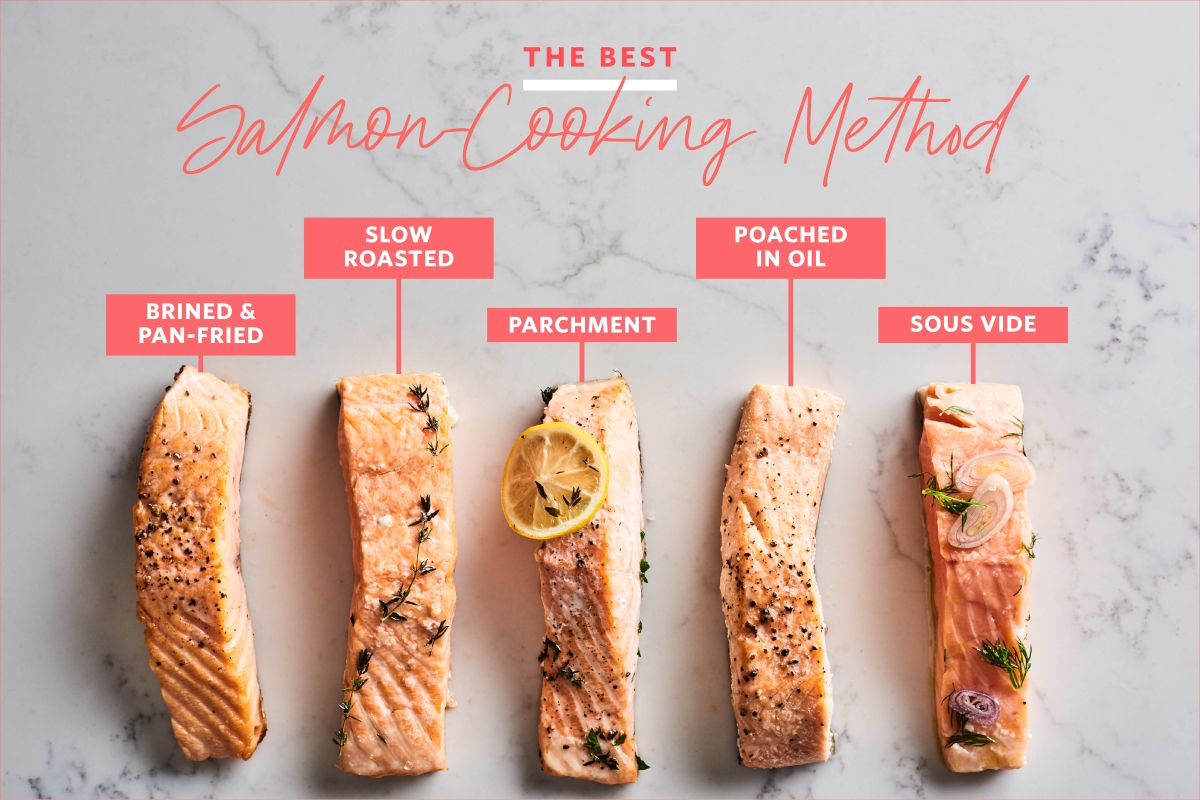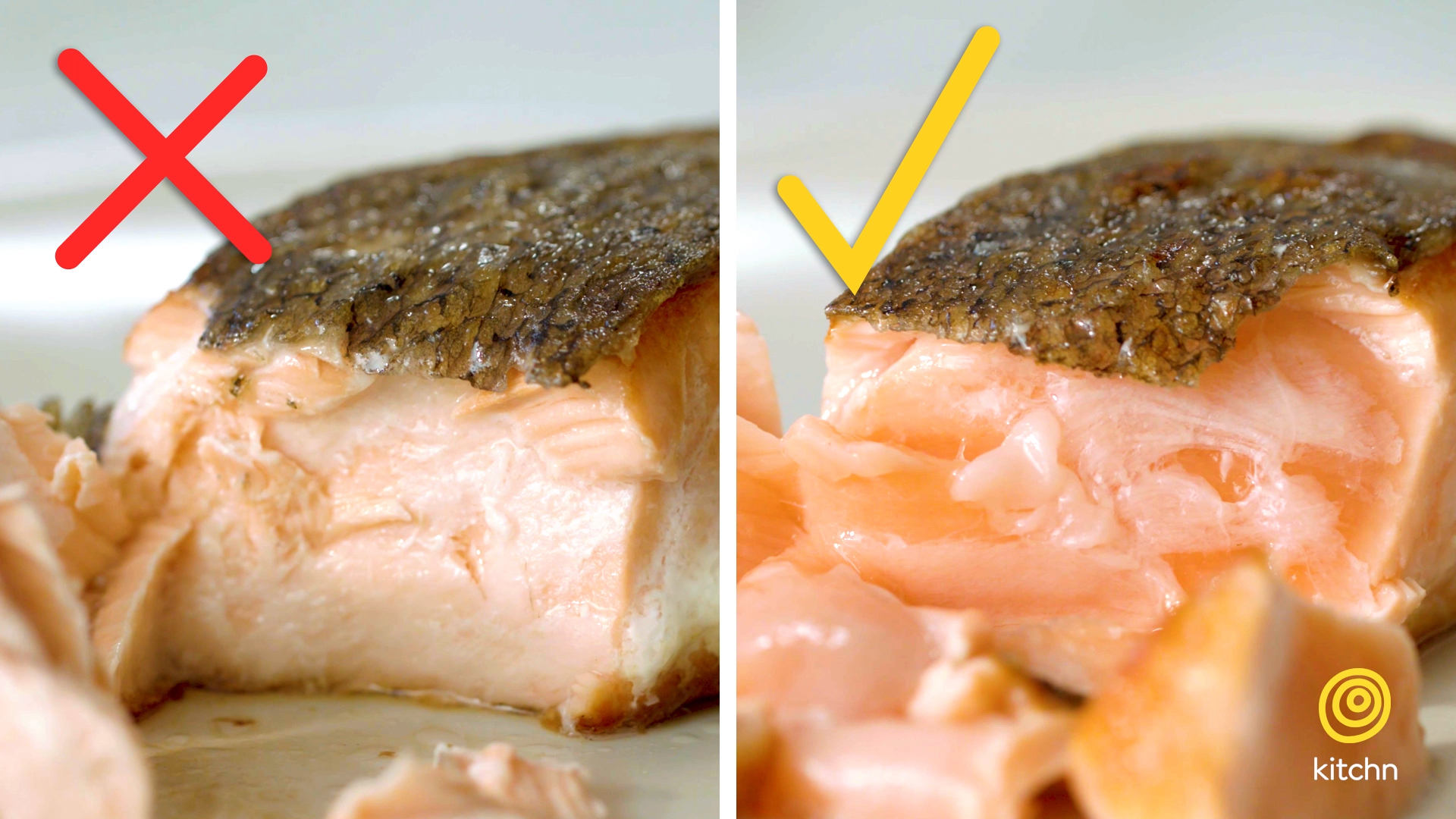The Best Way to Cook Salmon
After trying 5 different methods for cooking salmon, the winner is clear.
The Kitchn, Jill Waldbieser, Source - https://getpocket.com/explore/...source=pocket-newtab
 Photos: Joe Lingeman; Food Styling: Pearl Jones Design:Kitchn
Photos: Joe Lingeman; Food Styling: Pearl Jones Design:Kitchn
The last time I was in Alaska, I had the most amazing, delicate, flavorful salmon fillets I’ve ever had. The flesh was buttery, melt-in-your mouth perfection, and was unlike any salmon I was used to. And that’s probably because I had, to my surprise, been cooking it wrong all along.

What’s the Best Way to Cook Moist, Buttery Salmon?
The most common mistake when it comes to salmon is overcooking. In fact, we bet that many people haven’t ever really cooked their salmon to a true, melt-in-your-mouth state. What you probably think of as done is probably overdone. Salmon, like steak, can be served on a spectrum from rare to well-done inside. Fillets, especially a lean one like sockeye (which home chefs are more likely to encounter than king), can go from perfectly cooked to dried out in a matter of moments. As long as a salmon fillet reaches 145°F (or 120°F for medium-rare), even if it looks quite underdone, it is good to go.
Popular methods for cooking salmon vary wildly from pan-seared crispness to low-and-slow roasting. Now, it must be said that there are many solid, weeknight-friendly ways of cooking salmon that we rely upon. The two easiest and most common ways of cooking salmon are in the oven on a sheet tray at 425°F (like this one) and on the stovetop with a little oil (like this one).
But what if I really wanted to reproduce the salmon I loved so much in Alaska? Which method provides the most return in the form of buttery, moist salmon, with the least chance of overcooking? I tried five different methods for cooking the most melt-in-your-mouth salmon and found one clear winner.
How I Tested Salmon-Cooking Methods
All tests were conducted using 6-ounce fillets of Copper River Wild Sockeye Salmon, patted dry, plus extra-virgin olive oil, kosher salt, and fresh ground pepper. When it came to rating each method, I was looking for a few things. First, I knew that I wanted that meltingly soft salmon. But an evenly cooked, perfectly flaky fillet wasn’t enough; I also wanted flavor and ease, with a method that required little time, effort, or expertise.
Salmon Method: Slow-Roasted in the Oven
- Method Details: Roast skin-down at 275°F for 15 to 35 minutes, or until fish hits temperature of 120°F
- Cooking Time: 28 minutes
- Rating: 5/10
About this method: Slow roasting seemed like the obvious starting point, but I was worried that the technique I chose to follow was almost too low at 275 degrees F. It did end up taking me toward the longer end of the suggested cooking time of 15 to 35 minutes, but it earned points for simplicity: Just brush the fillet with some EVOO, season it, and let the oven do its thing.
Results: I wasn’t a fan of how often I had to keep checking the temperature of the fish, and it was tough to pull it out at precisely 120 degrees; it registered 123 degrees when I pulled it out. It certainly was moist! I almost didn’t think it was cooked, it was so juicy. The low oven temp also meant that there wasn’t a lot of carryover cooking happening once it was out of the oven either, making it next to impossible to dry the salmon out using this method. But the flesh was still bright, seafood-counter red and didn’t feel quite as firm as I’d have liked, and the flavor was just so-so. Without high temperatures to crisp skin or cook the proteins and render the fats, it was kind of bland. (If you’re still a fan of this method’s hands-off cooking, though, we think our own slow-roasted salmon recipe, which adds a lot more flavor and aromatics, may be good for you and would have ranked higher).
Salmon Method: Poached in Olive Oil
- Method Details: Heat olive oil in a deep pan to 120°F. Bake the fish in the hot oil for 25 minutes
- Cooking Time: 1 hour plus 25 minutes
- Rating: 6/10
About this method: This less-traditional method, a kind of salmon confit, is often used to cook tuna in its own fat. As the directions specified, I seasoned the fillet and let it come to room temperature before placing it in an oven-safe pan and covering it with olive oil. It’s really important to fully submerge the entire fillet if you want it to cook evenly, and that can mean a lot of oil. Heat over low heat until the oil reaches 120 degrees F, at which point you’ll transfer the entire pan to a 225-degree F preheated oven for 25 minutes.
Results: I will admit that this method yielded the best-tasting salmon — but what would you expect from cooking something in fat? The oil infused the fillet with flavor and kept it moist, but not wet, and cooked it to just-yielding perfection. But the technique is fussy, and messy, and expensive (you can reuse the oil, but how often are you really poaching fish?) and despite starting the fish at room temperature, I felt the cooking was still uneven, with some spots flakier and others more rare.
Salmon Method: Sous Vide
- Method Details: Cook in a sealed sous vide bag at 120°F for 30 minutes
- Cooking Time: 30 minutes plus at least 30 minutes marinade time
- Rating: 8/10
About this method: If you’re treating salmon like steak (as you should), then sous vide might be your jam. Fans of this technique, which is basically cooking vacuum-sealed proteins gently in a water bath, love its precision, which allows you to choose the exact doneness of your fish. I opted for 120 degrees F, which the accompanying chart described as “very moist, tender, and flaky.” After bringing the pot of water to that temperature and attaching my Joule sous vide, I placed my seasoned, oil-coated salmon in a bag into the water and set the timer. The device kept the water temperature at a constant while I walked away and did other things.
Results: The cook time of 30 minutes is a bit longer than other methods, but you don’t need to pay attention and can use that time to prep side dishes. There’s also no cleanup involved after, and the salmon was superb and just as described. I prefer my salmon a little firm and flaky and maybe this close to being overdone, and this hit that mark exactly. The only fussy bit is needing to use a marinade if you want to add any aromatics or flavors. Also, of course, needing a sous vide setup, which is still not a common piece of gear for most home cooks.
Salmon Method: Baked in a Parchment Paper Packet
- Method Details: Bake in a crimped-shut parchment paper packet at 375ºF for 12 to 14 minutes.
- Cooking Time: 15 minutes
- Rating: 8.5/10
About this method: Cooking en papillote is the fancy French way for saying “in paper.” Parchment packets are designed for cooking individual portions, and basically steam the contents so everything comes out moist and delicious. I followed this method, but only added salmon and oil, no vegetables, to the parchment oval, then crimped the edges and put the whole baking sheet in a 375-degree F oven.
Results: Now this is a foolproof method, and fast, too. I reduced the cooking time slightly since I was doing salmon solo, but even at 12 minutes a thermometer read 144 degrees. I thought for sure my fillet would be overcooked and dry, but was surprised to discover it was far from it. Some areas were pinker than others, but overall it was tasty, plenty moist, yet still slightly firm. And the cleanup was effortless.
Salmon Method: Brined and Pan-Seared
- Method Details: Brine for 15 minutes in salt water. Sear in a nonstick pan over medium-high heat for 12 to 16 minutes total, flipping once.
- Cooking Time: About 30 minutes total
- Rating: 10/10
About this method: Wet brining has always worked wonders on chicken for me, and salmon spends half its life in salt water anyway, so this method made sense to me. After a quick 15-minute soak, I patted the fillet off and placed it in a dry, cold pan, fired the heat to medium-high, and cooked it for six minutes per side. Boom, done.
Results: I love anything you can start in a cold pan because I’m too impatient for pre-heating. This method didn’t use fat but somehow still managed to deliver the fish that was almost as flavorful as the fillet cooked in oil. The combination of brine and higher heat produced a moist, flaky fillet with a still-pink and tartare-esque center, like a perfectly medium-rare steak. It was fast, easy, and delicious. Winner, winner, salmon dinner.
